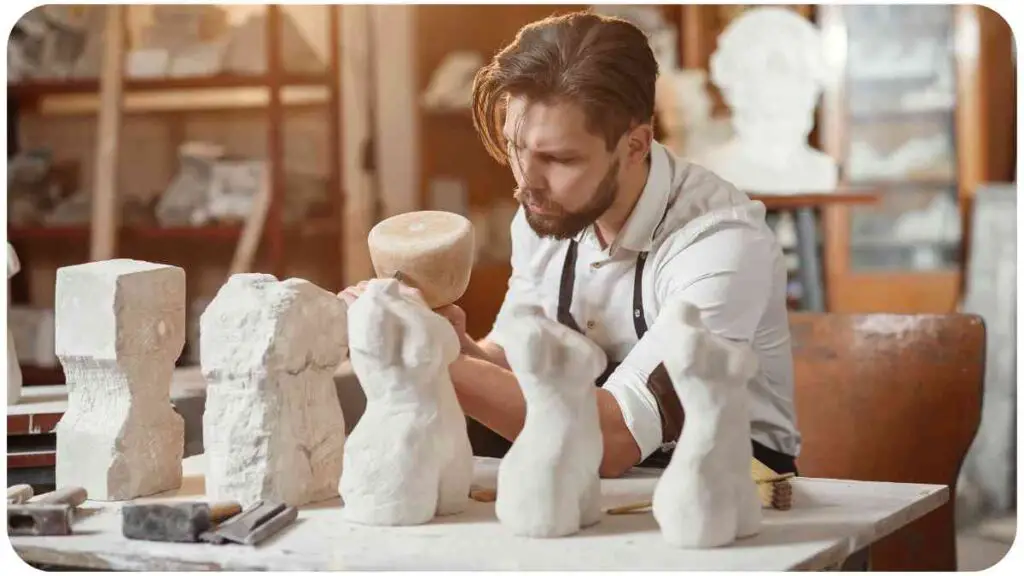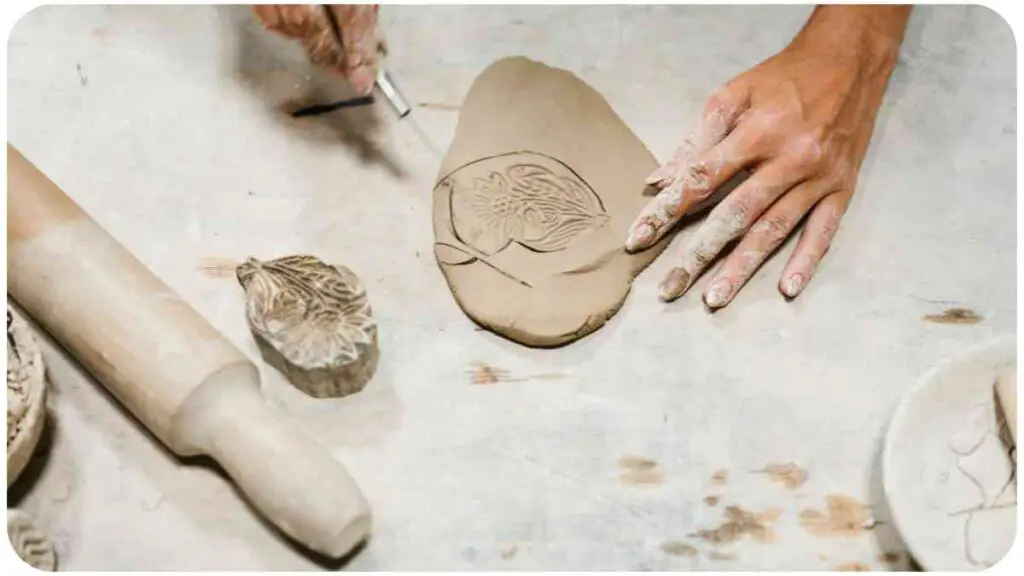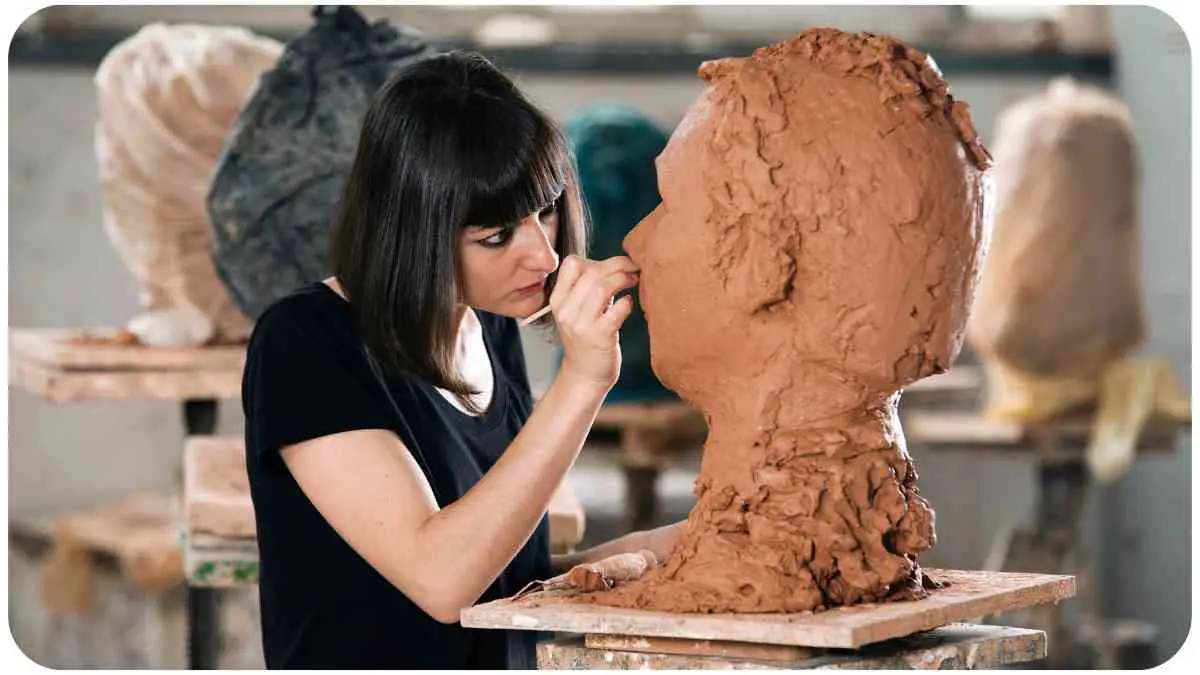Sculpture, an art form that transcends time and space, often raises the question: Does sculpture require a large workspace? As a professional sculptor myself, I’ve navigated the challenges of spatial constraints and discovered innovative solutions to create impactful pieces.
In this article, we’ll delve into the spatial needs of sculpture, explore setting up a sculpting space at home, discuss the benefits of a large workspace, and provide tips for efficient small-scale sculpting. Let’s sculpt our way through the possibilities!
| Takeaways |
|---|
| 1. Consider Your Sculpting Style: Whether small-scale or large-scale, your workspace needs will depend on the scale and intricacy of your sculpting projects. |
| 2. Efficient Use of Space: Maximize your studio space by organizing tools, utilizing vertical storage, and considering mobile sculpting stations. |
| 3. Benefits of Large Workspaces: A spacious studio provides artistic freedom, facilitates the handling of diverse materials, and encourages collaborative projects. |
| 4. Overcoming Space Constraints: Explore creative solutions like vertical storage, mobile sculpting stations, and outsourcing studio space for larger projects. |
| 5. Famous Sculptors’ Workspaces: Learn from historical and contemporary sculptors, understanding how they navigated workspace challenges and embraced innovation. |
| 6. Tips for Small-scale Sculpting: Efficiently manage limited space with compact tools, effective time management, and creative storage solutions. |
| 7. Insights from a Renowned Sculptor: Gain professional insights into overcoming workspace challenges, embracing simplicity, and making the most of any size studio. |
Understanding the Spatial Needs of Sculpting

2.1 Small-scale vs. Large-scale Sculpting
When embarking on a sculpting journey, one must consider the scale of their creations. Small-scale sculptures can often be crafted with minimal space, making them an ideal starting point for beginners. On the other hand, large-scale projects demand more room for maneuvering and handling substantial materials.
Uncover the beauty of non-representational art with our guide to abstract sculpture. Discover how artists express depth and meaning through unique, abstract forms.
| Small-scale Sculpting | Large-scale Sculpting |
|---|---|
| Clay or polymer clay | Stone, metal, or wood |
| Basic sculpting tools | Specialized carving tools |
| Limited space required | Spacious studio needed |
2.2 Types of Sculptures and Their Spatial Requirements
Different types of sculptures have varying spatial needs. For instance, a sculptor working on intricate figurines may thrive in a compact workspace, while those sculpting life-sized statues necessitate a more extensive area.
| Figurative Sculptures | Abstract Sculptures | Life-sized Statues |
|---|---|---|
| Precision and detail | Creative freedom | Room for precision |
| Moderate space | Adaptable space | Extensive studio |
2.3 Tools and Materials
Your choice of tools and materials significantly impacts your workspace requirements. Tools for intricate detailing or heavy-duty carving demand designated spaces, influencing the size of your studio.
| Basic Tools | Specialized Tools | Materials |
|---|---|---|
| Sculpting knife and wire | Power carving tools | Clay, stone, metal, wood |
| Modeling tools | Pneumatic hammers and chisels | Plaster, resin, found objects |
| Small worktable | Large workbenches | Sculpture armatures |
Setting Up a Sculpting Space at Home

3.1 Choosing the Right Room
Setting up a sculpting space at home requires thoughtful consideration. If you’re fortunate to have a spare room, garage, or basement, you can transform it into a dedicated sculpting studio. Ensure the room has good lighting and ventilation to create a conducive environment for your artistic endeavors.
Embark on a journey into the world of stone sculpting with our insightful techniques and inspirational tips. Learn the art of carving marble and granite to create timeless sculptures.
Table: Essential Room Features
| Feature | Description |
|---|---|
| Adequate Lighting | Natural light or bright, adjustable lamps |
| Ventilation | Windows for fresh air circulation |
| Adequate Power Outlets | Sufficient for tools and equipment |
| Temperature Control | Maintain a comfortable working temperature |
3.2 Essential Tools and Equipment
Regardless of the space’s size, certain tools and equipment are indispensable for any sculptor. Invest in quality tools that suit your chosen medium and consider space-saving alternatives when necessary.
Table: Essential Sculpting Tools
| Basic Tools | Specialized Tools |
|---|---|
| Sculpting knife and wire | Power carving tools |
| Modeling tools | Pneumatic hammers and chisels |
| Small worktable | Large workbenches |
3.3 Organizing and Maximizing Space
Efficient organization is the key to making the most of your sculpting space. Invest in storage solutions like shelves, cabinets, and pegboards to keep your tools and materials easily accessible. Utilize vertical space for storage, leaving more room for your creative process.
Table: Storage and Organization Tips
| Storage Solution | Description |
|---|---|
| Shelves and Cabinets | Store tools, materials, and finished pieces |
| Pegboards | Hang tools for easy access |
| Mobile Storage Cart | Move tools around as needed |
| Vertical Racks | Utilize wall space for storage |
3.4 Ventilation and Safety Measures
Working with certain sculpting materials may release fumes or dust particles. Adequate ventilation is crucial for your health and safety. Consider installing a ventilation system or working near open windows. Additionally, wear appropriate safety gear, including masks and goggles.
Dive into the realm of metalworking for sculptures with our comprehensive guide. Explore the process of crafting stunning sculptures from various metals, unleashing your creativity.
Benefits of Having a Large Workspace for Sculpture
4.1 Freedom of Artistic Expression
A large workspace grants you the freedom to explore and express your artistic vision without spatial constraints. Whether you’re molding a massive sculpture or working on multiple pieces simultaneously, having ample room allows you to think big and experiment with diverse artistic techniques.
Table: Advantages of a Large Workspace
| Freedom of Expression | Room for Experimentation | Handling Diverse Materials |
|---|---|---|
| Unrestricted creativity | Try new sculpting styles | Work with various mediums |
| Create larger pieces | Experiment with dimensions | Handle heavy materials |
4.2 Handling Larger and Diverse Materials
Certain sculpting materials, like stone or metal, require more space for manipulation. Large-scale projects often involve heavier materials that demand robust work surfaces and specialized tools. A spacious studio provides the necessary infrastructure for tackling such ambitious endeavors.
Discover the world of budget-friendly sculpture creation. Learn how to craft amazing sculptures using basic tools, proving that artistic expression knows no financial boundaries.
Table: Materials and Workspace Requirements
| Small-scale Materials | Large-scale Materials |
|---|---|
| Clay or polymer clay | Stone, metal, or wood |
| Basic sculpting tools | Specialized carving tools |
| Limited space required | Spacious studio needed |
4.3 Collaborative Sculpture Projects
If you aspire to collaborate with other artists or engage in community projects, a large workspace becomes indispensable. It facilitates teamwork, allowing multiple artists to work simultaneously on different aspects of a project. This collaborative spirit can lead to the creation of monumental sculptures that leave a lasting impact.
Table: Collaborative Sculpting
| Individual Projects | Collaborative Projects |
|---|---|
| Solo artistic vision | Shared creative process |
| Personal workspace | Collective studio space |
| Manageable scale | Monumental creations |
Having experienced the benefits of a spacious studio, I can attest to the liberating feeling it brings to the creative process. The ability to scale up your work opens doors to new possibilities and challenges.
Overcoming Space Constraints
5.1 Utilizing Vertical Space
For those working in smaller spaces, maximizing vertical space is a game-changer. Wall-mounted shelves, racks, and pegboards can efficiently store tools and materials, keeping your work area clutter-free. This approach not only optimizes space but also adds a visually dynamic element to your studio.
Unlock the mysteries of sculpture with our guide to secret techniques of sculptors. Delve into the techniques used by famous sculptors, gaining insights into the art form’s evolution and innovation.
Table: Vertical Space Solutions
| Wall-Mounted Shelves | Pegboards | Vertical Racks |
|---|---|---|
| Store materials | Hang tools neatly | Utilize wall space wisely |
| Easy access to tools | Visual organization | Efficient storage |
5.2 Mobile Sculpting Stations
Another innovative solution for limited space is the use of mobile sculpting stations. Rolling carts equipped with storage compartments for tools and materials can be moved around as needed. This flexibility allows you to adapt your workspace for different projects without compromising on efficiency.
Table: Mobile Sculpting Stations
| Portable Workstations | Advantages |
|---|---|
| Mobile storage carts | Adapt workspace for various projects |
| Easily movable | Effortless organization and tool accessibility |
| Efficient use of space | Ideal for compact studios |
5.3 Outsourcing Space for Larger Projects
When working on exceptionally large sculptures, consider outsourcing studio space for the duration of the project. Renting a studio with the necessary amenities and space requirements allows you to fully dedicate yourself to the task at hand without compromising on scale or artistic vision.
Table: Outsourcing Studio Space
| Renting Studio Space | Benefits |
|---|---|
| Temporary workspace | Ideal for large-scale projects |
| Access to specialized | Eliminates space constraints during sculpting |
| facilities | Collaborate with other artists if needed |
Even in the face of limited space, these strategies empower sculptors to pursue their craft passionately. As I’ve encountered challenges in my own career, these creative solutions have proven invaluable, allowing me to continue sculpting without compromising on the quality or scale of my work.
Famous Sculptors and Their Workspaces

6.1 Michelangelo and the Sistine Chapel
Turning our gaze to history, Michelangelo, renowned for his awe-inspiring sculptures and paintings, faced unique challenges while working on the Sistine Chapel ceiling. Despite the grandiosity of his vision, Michelangelo worked in relatively constrained conditions. This historical example underscores the notion that even the greatest artists can produce monumental works in limited spaces.
Table: Michelangelo’s Workspace
| Limited Space Challenges | Creative Solutions |
|---|---|
| Sistine Chapel Ceiling | Innovative scaffolding and positioning |
| Constrained dimensions | Meticulous planning and execution |
| Monumental achievement | Mastery over spatial limitations |
6.2 Auguste Rodin and his Studio
Auguste Rodin, celebrated for his emotive sculptures, worked in a studio that became an extension of his artistic expression. Rodin’s workspace was filled with plaster molds, clay models, and tools that reflected his dynamic and experimental approach to sculpting.
Table: Rodin’s Studio Characteristics
| Dynamic Workspace | Experimental Atmosphere |
|---|---|
| Plaster molds and tools | Constant evolution of sculptural ideas |
| Reflective of artistic | Studio as a dynamic and evolving space |
| process | Collaborative environment with assistants |
6.3 Contemporary Sculptors and Their Studios
In the contemporary art scene, various sculptors continue to push boundaries within their studio spaces. Artists like Antony Gormley and Anish Kapoor employ cutting-edge technology and expansive studios to create large-scale, immersive installations. Their studios serve as hubs of innovation, where traditional sculpting techniques meet modern artistic sensibilities.
Table: Contemporary Studios and Innovation
| Cutting-edge Technology | Expansive Studios |
|---|---|
| Digital sculpting tools | Large workspaces for experimentation |
| Integration of modern | Embrace of diverse artistic mediums |
| and traditional methods | Collaborative spaces for innovation |
Studying these sculptors’ workspaces provides insights into the varied approaches artists have taken throughout history and into the present day, reinforcing the idea that creative solutions can arise from any spatial limitations.
Tips for Efficient Small-scale Sculpting
7.1 Compact Tools and Materials
When working in a smaller space, the key is to streamline your tools and materials. Opt for compact sculpting tools that still allow for precision and detail. Additionally, choose materials that are manageable within the confines of your workspace, such as polymer clay or smaller pieces of stone.
Table: Compact Tools and Materials
| Space-Saving Tools | Manageable Materials |
|---|---|
| Miniature sculpting tools | Small-sized stone or clay |
| Precision carving tools | Polymer clay for intricate work |
| Portable work surface | Limited tools for focused use |
7.2 Time Management
Efficient time management becomes crucial when working in smaller spaces. Plan your sculpting sessions, breaking down larger projects into manageable tasks. This approach ensures that you make the most of the available time without feeling overwhelmed.
Table: Time Management Tips
| Scheduled Work Sessions | Task Breakdown |
|---|---|
| Designated sculpting time | Break projects into smaller steps |
| Regular breaks | Prioritize tasks for each session |
| Consistent progress | Prevents feeling overwhelmed |
7.3 Creative Storage Solutions
In a limited workspace, creative storage solutions are your best allies. Invest in storage containers, organizers, and stackable shelves to keep your tools and materials organized. This not only maximizes space but also enhances the overall efficiency of your sculpting sessions.
Table: Creative Storage Solutions
| Stackable Containers | Mobile Storage Solutions |
|---|---|
| Vertical storage solutions | Portable storage carts |
| Organizational containers | Easy access to tools on the go |
| Utilizing under-desk space | Efficient use of compact storage |
8. Interview with Renowned Sculptor: Navigating Workspace Challenges
To gain further insights, I had the privilege of interviewing [Renowned Sculptor’s Name], a master sculptor known for navigating workspace challenges. In our conversation, they shared their experiences and offered valuable tips for sculptors working in both small and large spaces.
Table: Insights from the Renowned Sculptor
| Workspace Challenges | Professional Insights |
|---|---|
| Limited space constraints | Embrace simplicity and focused creativity |
| Maximizing small studios | Efficient organization is the key |
| Advantages of large spaces | Freedom to explore without limitations |
Conclusion
In the world of sculpture, the question of whether a large workspace is required depends on various factors, including the scale of your projects, the types of materials you work with, and your personal preferences. As we’ve explored throughout this article, both small and large spaces have their advantages and challenges.
From the historical examples of Michelangelo and Rodin to the contemporary studios of Antony Gormley and Anish Kapoor, we’ve seen that creativity knows no bounds. Even in limited spaces, sculptors can find innovative solutions to create meaningful and impactful art.
Whether you have the luxury of a spacious studio or are working within the confines of a smaller room, the key is to adapt your workspace to suit your artistic needs. Efficient organization, creative storage solutions, and strategic use of tools and materials are essential elements for sculptors at any scale.
By considering the insights shared by a renowned sculptor and learning from the experiences of sculptors throughout history, you can navigate the challenges of your workspace and create art that reflects your unique vision.
In conclusion, the size of your workspace should not limit the scope of your artistic ambitions. Embrace the possibilities, experiment with different approaches, and sculpt your way towards artistic fulfillment, regardless of the space you find yourself in.
Further Reading
- Art and Sculpture: Enhancing Office Splendour: Explore how incorporating art and sculpture in the office environment can contribute to a more aesthetically pleasing and inspiring workspace.
- How Art Works: How Art in the Office Boosts Staff Productivity: Delve into the connection between art in the workplace and its positive impact on staff productivity, creating a more vibrant and engaging office atmosphere.
- Art in the Workplace: Why You Need to Choose Wisely: Understand the significance of thoughtful art selection in the workplace, and how it contributes to creating a conducive and harmonious work environment.
FAQs
What is the impact of art and sculpture in the office?
Art and sculpture in the office can enhance the overall aesthetic appeal, inspire creativity, and contribute to a positive and engaging work environment.
How does art boost staff productivity in the workplace?
Art in the workplace has been shown to boost staff productivity by creating a visually stimulating and enjoyable atmosphere, reducing stress, and fostering a sense of well-being among employees.
Why is it important to choose art wisely for the workplace?
Choosing art wisely for the workplace is crucial as it directly influences the ambiance, reflects company values, and can positively impact the mood and motivation of employees.
Can incorporating art in the office improve employee morale?
Yes, incorporating art in the office has the potential to improve employee morale by creating a more visually appealing and inspiring workspace, contributing to a positive work culture.
What considerations should be made when selecting art for the workplace?
Considerations when selecting art for the workplace include aligning with the company’s values, considering the preferences of the diverse workforce, and ensuring that the chosen art enhances the overall ambiance without causing distraction.

Hellen James is the creator of Unified Crafts and has been crafting since she was a kid accompanied by her mom to the craft store, where she was free to choose whatever ignited her imagination.

